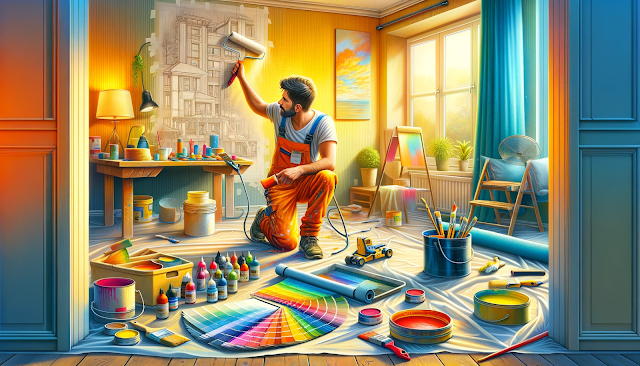Exploring the World of Professional Painting and Decorating
If you're drawn to a career where you can see the tangible results of your hard work, becoming a painter and decorator might be your calling. This field offers a rewarding blend of creativity and practical skill, perfect for those who love to work with their hands and bring spaces to life.
The Path to Professional Painting and Decorating
The journey to becoming a professional painter and decorator often begins with formal training. You can embark on this path through various routes, including college courses and apprenticeships. For example, a Level 2 or Level 3 Diploma in Painting and Decorating or a T Level in On-Site Construction can provide you with essential skills and knowledge. Apprenticeships, typically lasting 2 to 3 years, combine classroom learning with hands-on experience, allowing you to earn as you learn.
Daily Responsibilities and Skills Required
As a painter and decorator, your day-to-day tasks will vary. You'll be responsible for estimating material needs, preparing surfaces, applying various finishes like paint or wallpaper, and ensuring a clean workspace post-completion. To thrive in this role, attention to detail, teamwork, and customer service skills are crucial. You'll also need a good grasp of public safety and basic business management skills.
Working Environment and Hours
Expect a standard 40-hour work week, with potential overtime during peak construction periods. Your work could be indoors or outdoors, and it's physically demanding. Safety is paramount, and you'll be trained to work with caution to avoid injuries.
Apprenticeship: A Key Step
Apprenticeships are critical in this field. They typically involve both classroom studies and on-the-job training under a certified professional. These programs can vary but usually entail around three 12-month periods, including at least 3,900 hours of on-the-job training and technical training.
Career Progression Opportunities
With experience, you can progress to supervisory roles or branch into areas like contract management or interior design. Some painters and decorators even move into teaching or start their own business.
The Educational Journey: College Courses and Apprenticeships
Building a Strong Foundation through Education
Embarking on a career as a painter and decorator often begins with acquiring the right education and skills. This foundation is crucial for mastering the trade and ensuring a successful career path.
College Courses:
College courses offer structured learning and practical training. Pursuing a Level 2 or Level 3 Diploma in Painting and Decorating or a T Level in On-Site Construction can equip you with essential skills and open doors to trainee positions with decorating companies. These courses typically require GCSEs or equivalent qualifications for entry.
Apprenticeships:
An apprenticeship is a blend of classroom learning and hands-on experience under the guidance of a seasoned professional. Lasting about 2 to 3 years, apprenticeships allow you to earn while you learn, progressively building your skills and understanding of the trade. Entry into these programs usually requires some level of secondary education, often including GCSEs in English and maths.
The Role of Practical Experience
While theoretical knowledge is important, practical experience is invaluable in this field. It helps you apply what you've learned in real-world scenarios, hone your skills, and understand the nuances of different materials and techniques.
Mastering the Skills: Day-to-Day Responsibilities
Understanding the Role of a Painter and Decorator
A career as a painter and decorator is much more than just applying paint to walls. It involves a variety of tasks, each requiring a specific skill set and attention to detail.
Preparation is Key:
Before any paint or wallpaper touches a surface, thorough preparation is essential. This includes calculating the amount of material needed, laying down dust sheets, and preparing the surfaces. Stripping off old wallpaper, filling holes and cracks, and ensuring surfaces are level form the foundation of a good paint job.
Application Techniques:
The core of your work involves applying finishes like paint, wallpaper, and special treatments. This might include mixing paint to the right shade, often using computerized color-matching equipment, and then applying it using brushes, rollers, or spray equipment. Adding special finishes such as stains, varnishes, or marbling requires additional expertise.
Attention to Detail and Aesthetics:
As a painter and decorator, your role extends beyond the technical aspects of painting. Advising customers on color selection, understanding aesthetics, and providing a final touch that transforms a space are all part of the job. This requires an eye for detail and an understanding of how colors and textures work together.
The Satisfaction of a Job Well Done
There's a unique satisfaction in seeing a project through from start to finish. Whether it’s a residential living room or a large commercial space, the transformation that your skills can achieve is often the most rewarding aspect of this career.
The Work Environment: Challenges and Flexibility
Navigating the Physical and Varied Nature of the Job
The work environment for painters and decorators can vary greatly, presenting both challenges and opportunities for those in the field.
Work Hours and Conditions:
Typically, a painter and decorator can expect a 40-hour work week, but this can extend due to project demands, especially during peak construction periods. The nature of the work also means that painters and decorators can find themselves working in a variety of settings, both indoors and outdoors, which can be physically demanding. Weather conditions can particularly influence outdoor work, leading to longer hours in warmer months and reduced hours in colder periods.
Safety as a Priority:
In a field that often requires working at heights and handling potentially hazardous materials, safety is paramount. Painters and decorators are trained to work safely and take special precautions to protect against injury. This includes the use of protective gear, adherence to safety protocols, and staying informed about the latest safety practices.
Teamwork and Solo Projects:
While some projects may require working as part of a team, others might be solo endeavors. This variety can offer a mix of collaborative and independent working experiences, appealing to different work preferences and styles.
The Physical Aspect of the Job
Being a painter and decorator is physically demanding. It often involves standing for long periods, working with arms raised, and handling heavy equipment. This aspect of the job requires good physical fitness and stamina.
Apprenticeship: A Stepping Stone to Mastery
The Crucial Role of Apprenticeship in the Field
Apprenticeships serve as an essential gateway into the world of professional painting and decorating, blending theoretical knowledge with practical, hands-on experience.
Structure of Apprenticeships:
Typically spanning about three 12-month periods, apprenticeships in this field involve a mix of on-the-job training and classroom learning. As an apprentice, you work under the supervision of a certified Painter and Decorator, which allows for learning from experienced professionals. This period includes at least 3,900 hours of on-the-job training, combined with technical training and a final certificate exam.
Earning While Learning:
One of the key benefits of an apprenticeship is the opportunity to earn while you learn. Apprentices are paid for their work, usually starting at about 55% of a journeyperson's rate, with wages increasing as you gain more experience and skills.
Path to Certification:
In some regions, certification may be required or recommended for painters and decorators. Completing an apprenticeship is a common pathway to achieving this certification. In places like Canada, certification is voluntary but still advisable as it signifies a high level of skill and professionalism.
Advantages of Apprenticeship Programs
Apprenticeship programs provide a comprehensive understanding of the trade, covering various techniques, safety protocols, and customer service skills. They also offer a realistic view of what working in the field entails, preparing apprentices for a successful career.
Career Advancement: Growing Beyond the Brush
Exploring Paths for Professional Growth in Painting and Decorating
Advancement in the painting and decorating field is not only about honing technical skills but also about exploring diverse career paths that the industry offers.
From Apprentice to Supervisor:
With experience, a painter and decorator can rise to supervisory roles, overseeing projects and teams. This transition requires not only a deep understanding of painting and decorating techniques but also strong leadership and management skills.
Branching into Specialized Areas:
As you gain experience, you may find opportunities to specialize in areas like heritage conservation, interior design, or set design. These areas demand a more nuanced understanding of materials and creative approaches.
Entrepreneurship and Business Ownership:
Many painters and decorators choose to start their own business. This path offers the freedom to manage projects, develop client relationships, and create a personal brand in the industry.
Teaching and Mentorship:
For those passionate about sharing knowledge, teaching in a vocational setting or mentoring apprentices can be a fulfilling avenue. It allows experienced professionals to shape the next generation of painters and decorators.
The Importance of Continuous Learning
Staying updated with the latest techniques, materials, and trends is crucial in this evolving field. Continuous learning, whether through formal education or industry workshops, is key to career advancement.
Embracing the Future: Trends and Innovations in Painting and Decorating
Staying Ahead in a Rapidly Evolving Field
The world of painting and decorating is continually evolving, with new trends, materials, and technologies shaping the future of the profession.
Eco-Friendly Practices:
Sustainability is becoming increasingly important. Professionals in the field are adopting eco-friendly paints, materials, and practices to meet the growing demand for environmentally responsible decorating solutions.
Technological Advancements:
Technology is playing a bigger role, from computerized color-matching tools to advanced software for project management. Keeping up with these technological changes is essential for modern painters and decorators.
Innovative Materials and Techniques:
The industry is seeing the introduction of innovative materials and techniques, like textured paints and digital wallpaper printing. These advancements open up new creative possibilities for decorators.
Customer-Centric Services:
There's a growing focus on personalized services, understanding client needs, and delivering tailored decorating solutions. Building strong customer relationships is key to long-term success in the field.
Conclusion: A Career of Endless Possibilities
A career in painting and decorating offers a blend of creativity, technical skill, and the satisfaction of transforming spaces. With continuous learning and adaptation to industry changes, it can be a fulfilling and dynamic profession.










Comments
Post a Comment